傳奇的LED驅(qū)動器,可簡化以矩陣或數(shù)字顯示形式控制多個LED的過程���。在MAXREFDES99#中�,四個MAX7219 IC采用菊花鏈形式連接����,以驅(qū)動一個完整的256-LED陣列�,該陣列可以顯示任何
2018-04-02 10:55:00 6458
6458 本參考設(shè)計針對便攜式投影儀的6A降壓型LED驅(qū)動器于PWM HB LED驅(qū)動器MAX16821��,該電路可驅(qū)動一個LED;驅(qū)動RGB三色LED時需要使用三片MAX16821。
2020-03-26 07:46:19
MAX6955是一款緊湊型顯示驅(qū)動器��,通過I2C兼容的2線串行接口將微處理器接口至7�、14和16段LED顯示器���。串行接口支持多片MAX6955的級聯(lián)�。MAX6955可驅(qū)動多達(dá)16位7段�����、8位14段
2021-04-15 07:12:15
MAX16801A/B和MAXl6802A/B采用恒定電流來驅(qū)動一般照明和顯示應(yīng)用中的HB LED���,以提供所需要的控制功能�����。MAX16801A/B適用于通用交流輸入LED驅(qū)動器,而MAX
2019-10-11 06:02:25
MAX16826提供增強散熱的5mmx 5mm��、32引腳TQFN封裝����。提供可編程開關(guān)頻率(100kHz至1MHz)�,能夠降低汽車顯示屏等噪聲敏感應(yīng)用中的電磁干擾(EMI)��。另外,每個吸電流驅(qū)動器均具有直接PWM輸入����,可獨立控制每通道LED亮度��。
2021-04-16 06:05:21
概述:MAX16804是MAXIM公司生產(chǎn)的一款高電壓350mA LED驅(qū)動器與模擬和PWM調(diào)光控制電路���。它為20腳QFN封裝。
2021-05-18 07:53:09
MAX1498是MAXIM公司研制的3位半和4位半��、單片ADC,帶有LED驅(qū)動器�����。它為雙列直插28腳封裝�。4/5位(±19�����,999計數(shù))器件內(nèi)置發(fā)光二極管(LED)驅(qū)動器,MAX1498工作在
2021-05-20 06:11:31
5~LED8)是單獨控制的����,驅(qū)動器能夠以100mA驅(qū)動閃光燈組中的每個白光LED(或總電流為400mA) �����。通過使用自適應(yīng)1倍壓模式���、125倍壓模式����、2倍壓模式電荷泵和超低壓差的電流調(diào)節(jié)器
2012-02-27 12:37:47
用于汽車尾燈(STOP和TAIL模式)的LED驅(qū)動器可以簡單地利用線性LED驅(qū)動器IC (例如:MAX16804)實現(xiàn),只需極少的外部元件���。請參見驅(qū)動器電路原理圖(圖1)和PCB布板(圖2)。流過
2011-01-02 13:49:09
MAX16834驅(qū)動LED電路
2019-10-25 08:36:31
MAXIM 公司推出的多位LED顯示驅(qū)動器�,是一種集成化的 串行 輸入/輸出 共陰極 顯示驅(qū)動器�����,采用3線串行接口傳送數(shù)據(jù)����,可直接與單片機(jī)接口連接���,用戶能方便修改其內(nèi)部參數(shù),以實現(xiàn)多位LED 顯示�����。...
2021-07-13 06:03:48
上圖是proteus仿真max6951的電路圖這個芯片是段位復(fù)用的芯片���,這幾天很困擾我的是數(shù)碼管的限流電阻怎么去取值,看了數(shù)據(jù)手冊也是一頭霧水 望指點�?啊 ���,我快瘋了,附上該芯片手冊
2015-01-18 10:23:56
本應(yīng)用筆記提供了MAXQ?匯編程序范例�����,說明MAXQ2000 SPI模塊與MAX6951/MAX6950的配合使用�。
2021-05-31 06:08:28
SFP激光器驅(qū)動器MAX3946資料下載內(nèi)容主要介紹了:MAX3946特性MAX3946引腳功能MAX3946內(nèi)部方框圖MAX3946典型應(yīng)用電路
2021-03-26 07:11:37
0 引 言Maxim公司推出的MAX16824/MAX16825是用于現(xiàn)代汽車半導(dǎo)體照明系統(tǒng)的三通道��、高亮度的LED(HB LED)驅(qū)動器,具有6.5~28V輸入電壓范圍���。該系列器件具有三路36V
2018-12-18 09:49:31
概述:MAX3967是MAXM公司生產(chǎn)的一款可編程LED驅(qū)動器�����,用于最高270Mbps數(shù)據(jù)速率的光發(fā)送器����。電路包括:帶可編程溫度系數(shù)的高速電流驅(qū)動器�、LED預(yù)偏置電壓調(diào)節(jié)以及禁用功能電路��。電路接受
2021-05-17 07:27:10
概述:MAX16834是電流模式高亮度LED (HB LED)驅(qū)動器���,可實現(xiàn)升壓��、升/降壓�、SEPIC及高邊降壓拓?fù)浣Y(jié)構(gòu)���。除了驅(qū)動由開關(guān)控制器控制的n溝道功率MOSFET開關(guān),該器件還可驅(qū)動n溝道
2021-05-17 06:49:06
概述:MAX8790是一款高效白光發(fā)射二極管(LED)驅(qū)動器��。該驅(qū)動器專為使用LED陣列作為光源的大型液晶顯示器(LCD)設(shè)計。電流模式升壓控制器可同時驅(qū)動具有多個LED串聯(lián)的6串LED���。每串LED都連接至恒流
2021-04-06 06:35:16
概述:MAX7360是MAXIM公司生產(chǎn)的一款LED驅(qū)動和控制器集成電路。他具有I2C接口外設(shè)能夠為微處理器管理多達(dá)64個按鍵開關(guān)���,附加的8路LED驅(qū)動器/GPIO具有固定電流����、PWM亮度調(diào)節(jié)及旋轉(zhuǎn)
2021-05-18 07:04:23
高壓��、可調(diào)恒流LED驅(qū)動器MAX16800及其應(yīng)用 MAX16800是MAXIM公司2005年8月份推出的新器件���,是一種可工作于高電壓�����、可設(shè)定恒流輸出的高亮度白色LED驅(qū)動器���。該
2009-12-11 12:02:30
概述:MAX16839可編程電流調(diào)節(jié)器工作在5V至40V輸入電壓范圍�����,具有漏極開路����、恒定吸電流輸出,可提供100mA輸出驅(qū)動���。MAX16839非常適合汽車應(yīng)用以及需要通用線性LED驅(qū)動器的應(yīng)用��。該
2021-05-17 06:03:47
概述:2相柵極驅(qū)動器MAX8811可控制多相同步降壓轉(zhuǎn)換器應(yīng)用中的功率MOSFET�����,為每相提供高達(dá)30A輸出電流�。MAX8811和MAX8810A(多相電源控制器)配合使用可提供高效���、低成本的解決方案�����,適合各種多相供...
2021-04-20 07:09:42
MAX6950/MAX6951是緊湊的共陰極顯示驅(qū)動器����,通過SPITM��、QSPITM����、MICROWIRETM兼容的串行接口�����,連接微處理器和獨立的7段LED數(shù)碼管�、條形圖或分立的LED���。電源電壓可低
2008-05-06 17:14:50 150
150 串行接口8位LED顯示驅(qū)動器:MAX7219/MAX7221是一種集成化的串行輸入/輸出共陰極顯示驅(qū)動器,它連接微處理器與8位數(shù)字的7段數(shù)字LED顯示�����,也可以連接條線圖顯示器或者64個獨立的LED���。其
2009-08-18 15:03:21 40
40 使用MAX6954驅(qū)動7段LED顯示器:本文旨在幫助工程師快速掌握 MAX6954 驅(qū)動7 段單色LED 驅(qū)動器的使用����。MAX6954 是一個通用顯示驅(qū)動器�,能夠通過一個串口控制多個分立�、7 段����、14 段或16
2009-10-02 13:46:44 46
46 MAX6950/MAX6951是緊湊的共陰極顯示驅(qū)動器�����,可通過SPI?�����、QSPI?����、MICROWIRE?兼容的串行接口將微處理器連接至獨立的7段LED數(shù)碼管�����、條形圖或離散的LED�����。電源電壓可低至
2023-07-04 10:14:46
MAX6950/MAX6951是緊湊的共陰極顯示驅(qū)動器,可通過SPI?����、QSPI?���、MICROWIRE?兼容的串行接口將微處理器連接至獨立的7段LED數(shù)碼管、條形圖或離散的LED��。電源電壓可低至
2023-07-04 10:17:23
MAX6950/6951是Maxim公司推出的串行接口LED顯示驅(qū)動器����,內(nèi)部集成16進(jìn)制譯碼器和亮度控制器��。介紹MAX6951的結(jié)構(gòu)特點、工作原理及與LPC2214型ARM微控制器配合使用的軟硬件實
2010-12-03 16:32:40 47
47 MAX16832A, MAX16832C 高亮度LED驅(qū)動器�����,2MHz��、集成MOSFET和高邊電流檢測
概述
MAX16832A/MAX16832C
2008-10-19 17:55:34 817
817 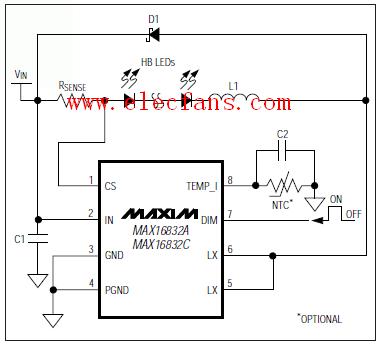
MAX16826 可編程、四串HB LED驅(qū)動器���,可優(yōu)化輸出電壓�,并具有故障檢測
MAX16826高亮度LED (HB LED)驅(qū)動器針對汽車LCD顯示器和其他顯示應(yīng)用(如工業(yè)或臺式計算機(jī)
2009-03-31 09:45:10 732
732 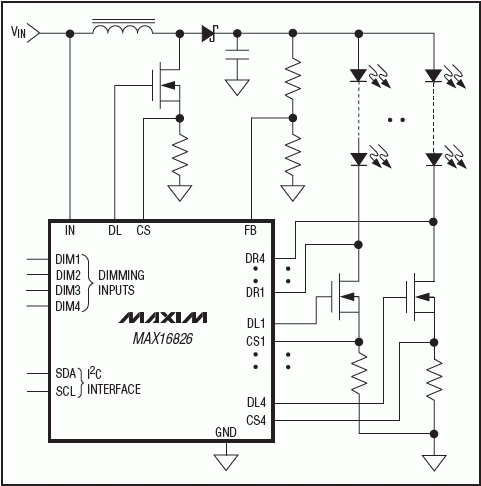
摘要:本應(yīng)用筆記說明MAX6951/MAX6950 LED驅(qū)動器和MAXQ2000的SPI外設(shè)通信的匯編程序設(shè)計����。
引言MAX6950和MAX6951分別為5位和8位共陰極LED顯示驅(qū)動器,通過高速SPI 接口控
2009-04-23 16:42:50 556
556 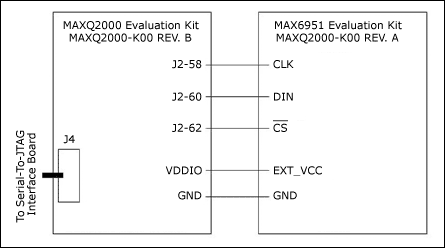
摘要:本應(yīng)用筆記說明MAX6951/MAX6950 LED驅(qū)動器和MAXQ2000的SPI外設(shè)通信的匯編程序設(shè)計�。
引言MAX6950和MAX6951分別為5位和8位共陰極LED顯示驅(qū)動器��,通過高速SPI 接口控
2009-04-26 16:28:36 597
597 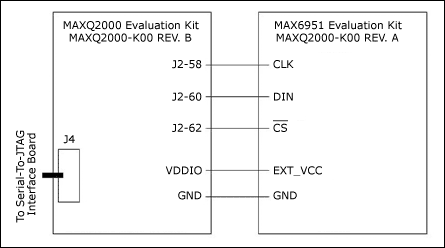
摘要:本應(yīng)用筆記說明MAX6951/MAX6950 LED驅(qū)動器和MAXQ2000的SPI外設(shè)通信的匯編程序設(shè)計����。
引言MAX6950和MAX6951分別為5位和8位共陰極LED顯示驅(qū)動器����,通過高速SPI 接口控
2009-04-26 17:17:58 624
624 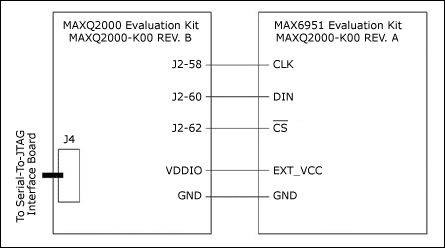
摘要:該應(yīng)用筆記詳細(xì)說明了如何使用MAX6958和MAX6959 LED顯示驅(qū)動器實現(xiàn)象素級(單個LED)亮度控制�。該技術(shù)增強了這些驅(qū)動器內(nèi)置的64級整體(一次調(diào)整所有LED)亮度控制功能����。
2009-04-27 09:01:05 932
932 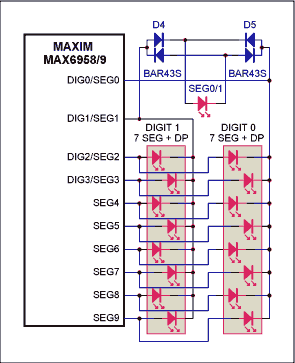
摘要:通過映射多個按鍵���,可以擴(kuò)展MAX6959 LED顯示驅(qū)動器的鍵盤掃描范圍����,從8鍵擴(kuò)展到12鍵��。該應(yīng)用筆記介紹了一種擴(kuò)展掃描的方法�。 MAX6959是4位、9段LED驅(qū)動器���,可自
2009-04-27 09:03:11 609
609 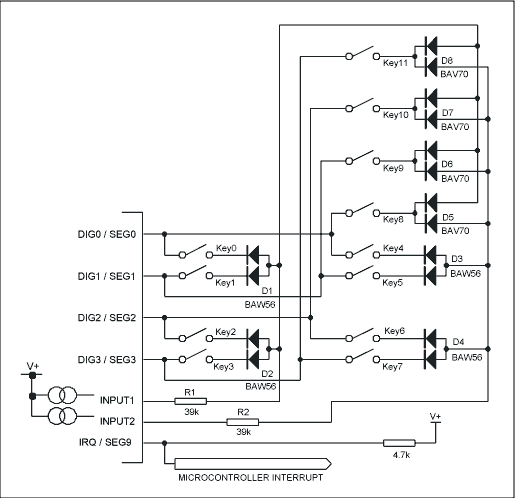
摘要:本文旨在幫助工程師快速掌握MAX6954驅(qū)動16段單色LED顯示器的使用方法����。 MAX6954是一個通用顯示驅(qū)動器�,能夠通過一個串口控制多個分立���、7段、14段或16段LED顯示器
2009-04-27 09:07:19 761
761 
摘要:本文旨在幫助工程師快速掌握MAX6954驅(qū)動14段單色LED顯示器的使用方法�����。
MAX6954是一個通用顯示驅(qū)動器,能夠通過一個串口控制多個分立����、7段、14段或16段LED顯
2009-04-27 09:08:08 1281
1281 
摘要:本文旨在幫助工程師快速掌握MAX6954驅(qū)動7段單色LED驅(qū)動器的使用方法�����。 MAX6954是一個通用顯示驅(qū)動器�����,能夠通過一個串口控制多個分立、7段�����、14段或16段LED顯示器
2009-04-27 09:09:03 925
925 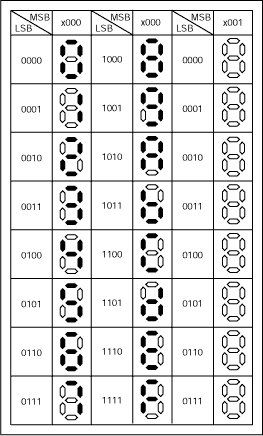
technique used by the MAX6950, MAX6951, MAX6954, MAX6955, MAX6958, and MAX6959 LED display drivers. This application note discus
2009-04-27 09:23:10 617
617 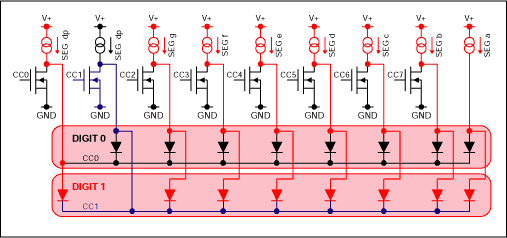
and software, between the older MAX7219 and MAX7221 LED display drivers and the newer MAX6950 and MAX6951 drivers. These drivers are five-digit or ei
2009-04-27 09:32:55 642
642 , evaluation, font design with MAX6950 and MAX6951 7-segment LED display drivers. The MAX6950 and MAX6951 are five-digit and eight
2009-04-27 09:44:05 789
789 
本文旨在幫助工程師快速掌握MAX6954驅(qū)動16段單色LED顯示器的使用方法。 MAX6954是一個通用顯示驅(qū)動器��,能夠通過一個串口控制多個分立、7段�、14段或16段LED顯示器����。本篇
2009-05-03 14:28:14 1311
1311 
摘要:本文旨在幫助工程師快速掌握MAX6954驅(qū)動14段單色LED顯示器的使用方法。
MAX6954是一個通用顯示驅(qū)動器�����,能夠通過一個串口控制多個分立���、7段��、14段或16段LED顯
2009-05-03 14:29:50 925
925 摘要:本文旨在幫助工程師快速掌握MAX6954驅(qū)動7段單色LED驅(qū)動器的使用方法�。 MAX6954是一個通用顯示驅(qū)動器��,能夠通過一個串口控制多個分立、7段��、14段或16段LED顯示器
2009-05-03 14:32:27 1047
1047 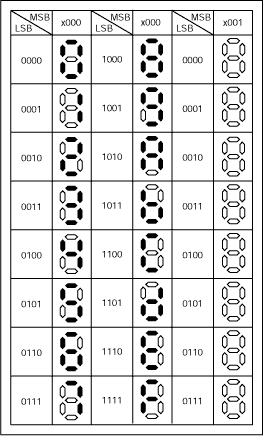
technique used by the MAX6950, MAX6951, MAX6954, MAX6955, MAX6958, and MAX6959 LED display drivers. This application note discus
2009-05-04 08:57:39 510
510 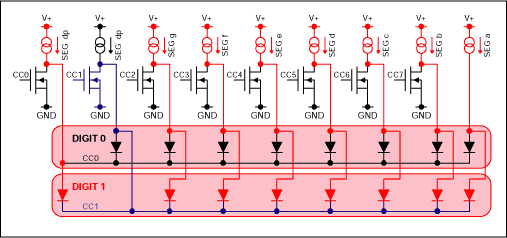
本應(yīng)用筆記介紹了一種擴(kuò)展掃描的方法�,可以擴(kuò)展MAX6954和MAX6955 LED顯示驅(qū)動器的鍵盤掃描范圍���,從32鍵擴(kuò)展到80鍵�����。 MAX6954/MAX6955是4線或2線串行接口的LED
2009-05-09 10:45:33 1258
1258 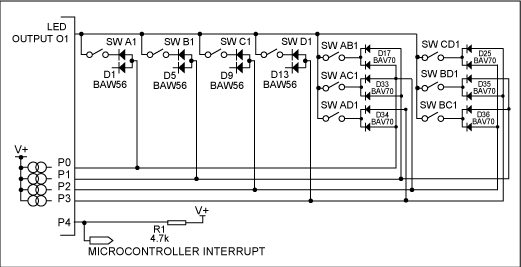
MAX6960大LED顯示屏編程指南
摘要:本文介紹了如何級聯(lián)配置多個8 × 8點陣LED驅(qū)動芯片MAX696x�����,實現(xiàn)大規(guī)模LED顯示屏或點陣的驅(qū)動�。該系列驅(qū)動器可最多菊鏈連接256個芯片
2009-07-18 11:15:26 1869
1869 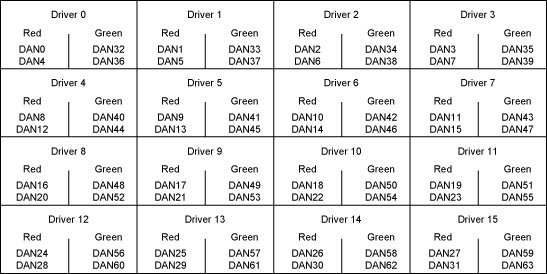
MAX7360 有8個GPIO/LED驅(qū)動器的8 x 8按鍵控制器���,集成可靠的ESD保護(hù)
2009-10-23 17:54:13 921
921 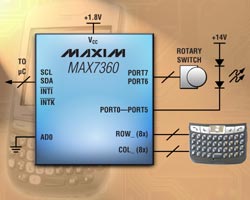
用于汽車尾燈(STOP和TAIL模式)的LED驅(qū)動器可以簡單地利用線性LED驅(qū)動器IC(例如:MAX16804)實現(xiàn)��,只需極少的外部元件�。圖1給出了對應(yīng)的電路原理圖���,圖2所示為PCB布板。流過LED的最大電
2009-12-11 21:33:06 860
860 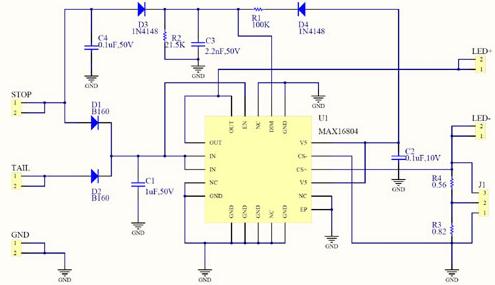
MAX15054 高邊MOSFET驅(qū)動器,用于HB LED驅(qū)動器和DC-DC應(yīng)用
概述
MAX15054是高邊�����、n溝道MOSFET驅(qū)動器��,高壓應(yīng)用中可工作在較高的開關(guān)頻率
2010-01-28 08:43:04 1653
1653 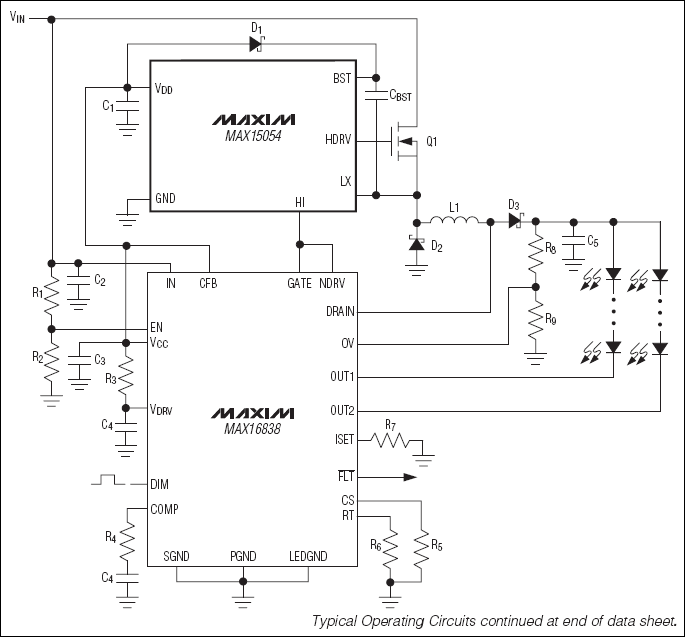
MAX16814 集成4通道��、高亮度LED驅(qū)動器��,提供高壓DC-DC控制器
概述
MAX16814高效率��、高亮度LED (HB LED)驅(qū)動器可提供多達(dá)四路的集成LED吸
2010-02-05 12:54:51 1886
1886 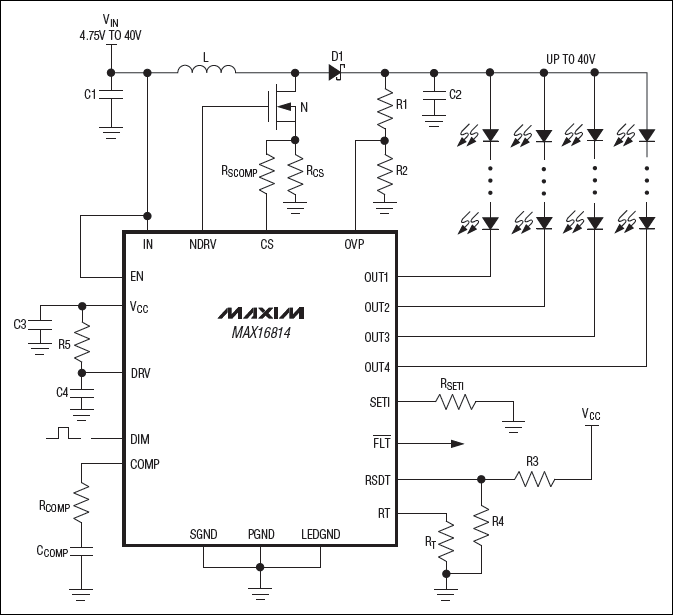
采用MAX16834設(shè)計buck-boost LED驅(qū)動器
本參考設(shè)計用于buck-boost LED驅(qū)動器。設(shè)計采用電流模式高亮度LED驅(qū)動器MAX16834����,利用MAX16834評估(EV)板實現(xiàn)此設(shè)計方案
2010-04-23 08:49:06 1314
1314 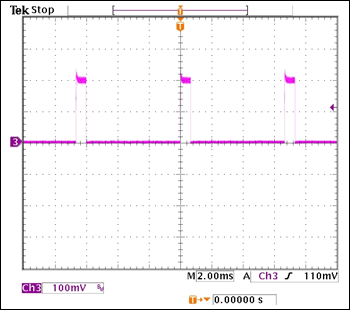
MAX16834構(gòu)成的LED驅(qū)動器電路原理圖
圖2. LED驅(qū)動器
2010-04-23 08:51:43 1273
1273 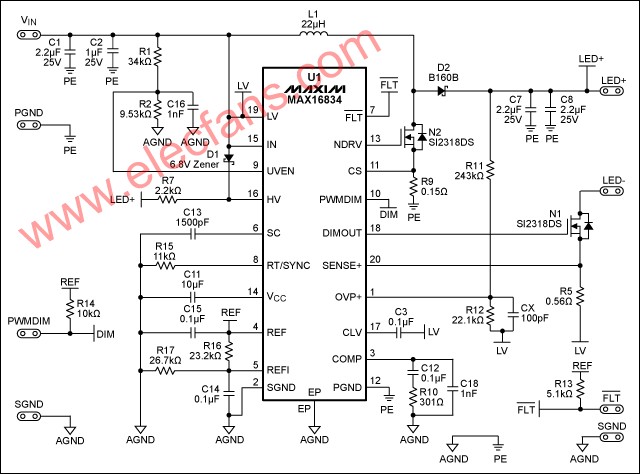
MAX6954/MAX6955 LED顯示驅(qū)動器允許用戶驅(qū)動獨立的LED數(shù)字或共用段驅(qū)動引腳����,本應(yīng)用筆記詳細(xì)說明了數(shù)字位映射的相關(guān)步驟。
2010-07-04 12:30:16 2436
2436 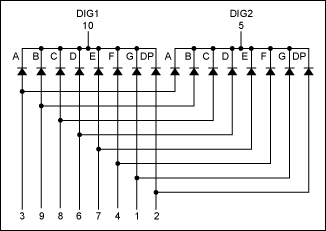
MAX16807是集成的��、高效白色或RGB LED驅(qū)動器。這器件為具有多個LED串的LCD背光或其他LED照明應(yīng)用而設(shè)計����。MAX16807的電流模式PWM控制器調(diào)整LED陣列所需的電壓����。根據(jù)輸入電壓和LED電
2010-09-15 09:38:26 1533
1533 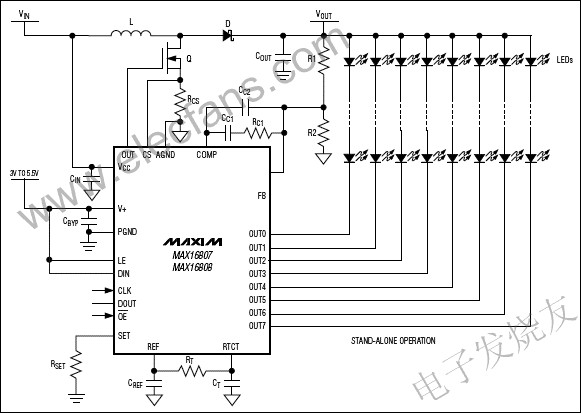
MAX6979串行接口LED驅(qū)動器可提供16個開漏����、恒流吸收、額定5.5V LED驅(qū)動器輸出�����。MAX6979采用3V至5.5V電源供電��。MAX6979和LED電源能以任意順序上電。
2011-01-20 09:39:12 616
616 
MAX16840為LED燈驅(qū)動器IC����,包含了12V AC和24V AC輸入(例如MR16) LED燈驅(qū)動器所需的全部功能,只需極少的外部元件
2011-06-02 11:35:08 1583
1583 
MAX16821的LED驅(qū)動器對10V至15V輸入電源電壓進(jìn)行降壓轉(zhuǎn)換����,恒流驅(qū)動一個正向?qū)妷簽?.5V至6V的LED���。
2011-12-24 00:13:00 2222
2222 
本文的MAX6955驅(qū)動器采用Maxim 公司推出的帶鍵盤掃描、LED 顯示�, 具有400kbps���、FC兼容白勺2線串行接口.可大大簡化設(shè)計�����。
2012-03-14 14:19:44 38
38 MAX6957 LED顯示驅(qū)動器及輸入/輸出擴(kuò)展器典型應(yīng)用電路
2012-05-17 11:19:39 1746
1746 
MAX6960–MAX6963是緊湊型陰極陣列顯示驅(qū)動器��,通過一個高速4線串行接口與微處理器連接��,實現(xiàn)8 x 8點陣紅色���、綠色和黃色(R,G�����,Y) LED顯示�����。
2013-01-07 10:30:23 2216
2216 
STC80C51-串行共陰極顯示驅(qū)動器MAX7219
2016-09-01 15:44:10 14
14 Max7219_LED顯示驅(qū)動器中文資料
2017-11-18 11:53:55 34
34 MAX7219是一種集成化的串行輸入共陰極顯示驅(qū)動器����,它連接微處理器與8位數(shù)字的7段數(shù)字LED顯示,也可以連接條線圖顯示器或者64個獨立的LED����。其上包括一個片上的B型BCD編碼器��、多路掃描回路���,段字驅(qū)動器���,而且還有一個8*8的靜態(tài)RAM用來存儲每一個數(shù)據(jù)。
2017-11-20 17:18:19 6809
6809 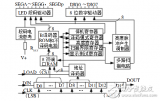
本文主要介紹了MAX7219驅(qū)動共陰極LED原理圖及程序�。MAX7219是一種串入�、并出的共陰極LED數(shù)碼管顯示驅(qū)動器����,每片可驅(qū)動8位LED數(shù)碼管顯示,與單片機(jī)的接口只需3根線�����,內(nèi)帶BCD譯碼器
2018-01-17 09:10:23 20812
20812 
MAX6972–MAX6975 是恒流LED 驅(qū)動器,用于高速彩色和視頻顯示電路板����。MAX6972/MAX6973可直接驅(qū)動16 個LED��,或者32 個復(fù)用LED��,而MAX6974/MAX
2019-05-15 08:08:00 2406
2406 
關(guān)鍵詞:LED驅(qū)動器 , MAX16821 , 降壓型 概述 本參考設(shè)計針對便攜式投影儀的6A降壓型LED驅(qū)動器于PWM HB LED驅(qū)動器MAX16821���,該電路可驅(qū)動一個LED;驅(qū)動RGB三色
2019-03-13 18:28:01 327
327 MAX7219/MAX7221是一種集成化的串行輸入/輸出共陰極顯示驅(qū)動器���,它連接微處理器與8位數(shù)字的7段數(shù)字LED顯示,也可以連接條線圖顯示器或者64個獨立的LED��。其上包括一個片上的B型BCD
2019-12-03 11:49:59 16
16 本文檔的主要內(nèi)容詳細(xì)介紹的是MAX7219多位LED顯示驅(qū)動器C語言程序免費下載���。
2020-04-24 17:19:48 17
17 MAX7219/MAX7221是一種集成化的串行輸入/輸出共陰極顯示驅(qū)動器,它連接微處理器與8位數(shù)字的7段數(shù)字LED顯示���,也可以連接條線圖顯示器或者64個獨立的LED。其上包括一個片上的B型BCD
2020-05-12 17:51:42 11
11 本文檔的主要內(nèi)容詳細(xì)介紹的是LED顯示驅(qū)動器MAX7219的PCB原理圖免費下載����。
2020-10-26 12:08:00 60
60 本應(yīng)用筆記是系列中的第一篇��,詳細(xì)介紹了 MAX16833 高壓高亮度 LED 驅(qū)動器的分步設(shè)計過程����,以加快原型設(shè)計并增加首次成功的機(jī)會��。MAX16833是峰值電流模式控制的LED驅(qū)動器���,能夠驅(qū)動多種
2021-06-15 11:20:54 5922
5922 
電子發(fā)燒友網(wǎng)為你提供MAX6954/MAX6955 LED顯示驅(qū)動器連接兩位LE資料下載的電子資料下載,更有其他相關(guān)的電路圖���、源代碼、課件教程�、中文資料�、英文資料、參考設(shè)計����、用戶指南��、解決方案等資料�,希望可以幫助到廣大的電子工程師們���。
2021-04-26 08:46:16 4
4 MAXIM 公司推出的多位LED顯示驅(qū)動器���,是一種集成化的 串行 輸入/輸出 共陰極 顯示驅(qū)動器��,采用3線串行接口傳送數(shù)據(jù)�,可直接與單片機(jī)接口連接����,用戶能方便修改其內(nèi)部參數(shù)�,以實現(xiàn)多位LED 顯示�。...
2021-12-06 09:36:10 26
26 2022-11-18 23:45:47 0
0 本應(yīng)用筆記詳細(xì)介紹了如何將MAX6958和MAX6959 LED顯示屏驅(qū)動器連接至5位LED顯示屏�����,適用于要求顯示范圍為-19999至19999(帶小數(shù)點)的面板儀表應(yīng)用���。
2023-01-11 15:14:00 840
840 
MAX6950和MAX6951為5位和8位共陰極LED顯示驅(qū)動器,通過高速SPI串行接口控制����。本應(yīng)用筆記描述了一個實用程序,允許通過PC控制MAX6950或MAX6951驅(qū)動器�。該實用程序可以單獨
2023-01-12 13:59:32 687
687 
本應(yīng)用筆記討論了由MAX6956或MAX6957靜態(tài)LED驅(qū)動器驅(qū)動同時改變顯示器所有LED段強度的技術(shù)(全局強度控制)��。此控制是對驅(qū)動程序已經(jīng)提供的逐段調(diào)整的補充����。該說明包括一個Excel電子表格形式的計算器�����,可以下載該計算器以輔助設(shè)計�����。
2023-01-12 15:30:42 570
570 
映射多個按鍵將MAX6959 LED顯示驅(qū)動器的按鍵掃描功能從8個按鍵擴(kuò)展到多達(dá)12個按鍵。本應(yīng)用筆記詳細(xì)介紹了如何擴(kuò)展該功能��。
2023-01-12 16:46:41 535
535 
本應(yīng)用筆記討論了在MAX6952和MAX6953的4線和2線串行接口LED顯示驅(qū)動器上增加面板LED強度控制的技術(shù)����。每個 LED 驅(qū)動器控制四個單色或兩個雙色 5 x 7 矩陣 LED 數(shù)字。多個驅(qū)動程序可以一起使用以形成消息顯示���。
2023-01-13 14:54:05 2188
2188 
本應(yīng)用筆記討論了由MAX6954或MAX6955多路復(fù)用LED驅(qū)動器驅(qū)動的顯示器所有LED數(shù)字的強度(即全局強度控制)的技術(shù)。此全局控制是對驅(qū)動程序已提供的逐位調(diào)整的補充���。該注釋包括一個電子表格計算器來輔助設(shè)計���。
2023-02-09 11:58:45 505
505 
電子發(fā)燒友網(wǎng)為你提供Maxim(Maxim)MAX6951CEE+T相關(guān)產(chǎn)品參數(shù)、數(shù)據(jù)手冊����,更有MAX6951CEE+T的引腳圖�����、接線圖�、封裝手冊�����、中文資料、英文資料�,MAX6951CEE+T真值表��,MAX6951CEE+T管腳等資料��,希望可以幫助到廣大的電子工程師們�。
2023-02-10 19:40:43

電子發(fā)燒友網(wǎng)為你提供Maxim(Maxim)MAX6951EEE+T相關(guān)產(chǎn)品參數(shù)�、數(shù)據(jù)手冊�����,更有MAX6951EEE+T的引腳圖�����、接線圖��、封裝手冊、中文資料�����、英文資料�����,MAX6951EEE+T真值表��,MAX6951EEE+T管腳等資料��,希望可以幫助到廣大的電子工程師們����。
2023-02-10 19:41:12

電子發(fā)燒友網(wǎng)為你提供Maxim(Maxim)MAX6950CEE+相關(guān)產(chǎn)品參數(shù)、數(shù)據(jù)手冊��,更有MAX6950CEE+的引腳圖����、接線圖���、封裝手冊、中文資料�����、英文資料,MAX6950CEE+真值表�����,MAX6950CEE+管腳等資料���,希望可以幫助到廣大的電子工程師們���。
2023-02-10 19:44:52

電子發(fā)燒友網(wǎng)為你提供Maxim(Maxim)MAX6951EEE+相關(guān)產(chǎn)品參數(shù)��、數(shù)據(jù)手冊,更有MAX6951EEE+的引腳圖����、接線圖�、封裝手冊、中文資料����、英文資料�����,MAX6951EEE+真值表,MAX6951EEE+管腳等資料���,希望可以幫助到廣大的電子工程師們。
2023-02-10 19:46:44

電子發(fā)燒友網(wǎng)為你提供Maxim(Maxim)MAX6951CEE+相關(guān)產(chǎn)品參數(shù)����、數(shù)據(jù)手冊���,更有MAX6951CEE+的引腳圖、接線圖��、封裝手冊���、中文資料�����、英文資料,MAX6951CEE+真值表���,MAX6951CEE+管腳等資料,希望可以幫助到廣大的電子工程師們���。
2023-02-10 19:47:06

電子發(fā)燒友網(wǎng)為你提供Maxim(Maxim)MAX6950EEE+相關(guān)產(chǎn)品參數(shù)、數(shù)據(jù)手冊�����,更有MAX6950EEE+的引腳圖����、接線圖��、封裝手冊����、中文資料�、英文資料,MAX6950EEE+真值表�,MAX6950EEE+管腳等資料�,希望可以幫助到廣大的電子工程師們。
2023-02-10 19:47:21

電子發(fā)燒友網(wǎng)為你提供Maxim(Maxim)MAX6950CEE+T相關(guān)產(chǎn)品參數(shù)��、數(shù)據(jù)手冊���,更有MAX6950CEE+T的引腳圖�、接線圖、封裝手冊、中文資料����、英文資料���,MAX6950CEE+T真值表����,MAX6950CEE+T管腳等資料���,希望可以幫助到廣大的電子工程師們����。
2023-02-10 20:19:23

電子發(fā)燒友網(wǎng)為你提供Maxim(Maxim)MAX6950EEE+T相關(guān)產(chǎn)品參數(shù)��、數(shù)據(jù)手冊�����,更有MAX6950EEE+T的引腳圖、接線圖��、封裝手冊�����、中文資料��、英文資料�����,MAX6950EEE+T真值表��,MAX6950EEE+T管腳等資料,希望可以幫助到廣大的電子工程師們�。
2023-02-10 20:24:05

MAX6950和MAX6951為2000位和16位共陰極LED顯示驅(qū)動器���,通過高速SPI接口控制�。這些器件采用獨特的多路復(fù)用方案����,以最大限度地減少 LED 驅(qū)動器和 LED 面板之間的連接
2023-02-20 10:16:21 757
757 
本應(yīng)用筆記討論了較舊的MAX7219和MAX7221 LED顯示驅(qū)動器與較新的MAX6950和MAX6951驅(qū)動器在硬件和軟件方面的異同��。這些驅(qū)動器是通過高速串行接口控制的五位或八位共陰極LED顯示驅(qū)動器�����。表 1 顯示了驅(qū)動程序之間的硬件差異。
2023-06-08 16:14:12 701
701 MAX6952和MAX6953為4位陰極排5×7矩陣LED顯示驅(qū)動器���,通過高速SPI(MAX6952)或I2C?控制(MAX6953) 串行接口。這些驅(qū)動程序主要用于字符顯示應(yīng)用��,其中單個 5×7 矩陣數(shù)字在物理上間隔開以形成一個或多個字符行(圖 1)�����。
2023-06-08 16:17:13 464
464 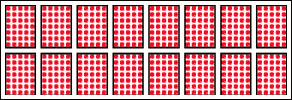
MAX6950和MAX6951為5位和8位共陰極LED顯示驅(qū)動器��,采用不尋常的多路復(fù)用方案。這種多路復(fù)用方案最大限度地減少了驅(qū)動器和LED顯示屏之間的連接��,但要求5位(MAX6950)或8位(MAX6951)的段連接不同(表1)�。
2023-06-08 16:20:19 768
768 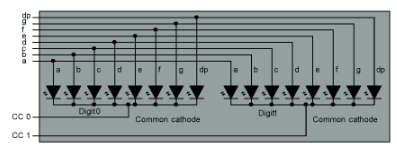
MAX6952和MAX6953為4位共行5x7矩陣LED顯示驅(qū)動器���,通過高速SPI?(MAX6952)或I2C (MAX6953)串行接口控制。本應(yīng)用筆記描述了一個實用程序�,允許通過PC控制
2023-06-08 16:26:51 576
576 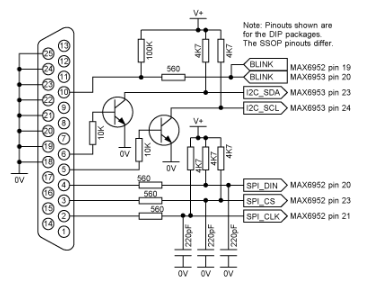
本文提出了幾種電路思路�,用于在LED斷開時保護(hù)升壓轉(zhuǎn)換器LED驅(qū)動器。(如果沒有保護(hù)�����,驅(qū)動器輸出會損壞外部MOSFET和肖特基二極管��。包括LED驅(qū)動器IC(MAX1698)和比較器(MAX9060或MAX9028)�。
2023-06-12 10:16:23 660
660 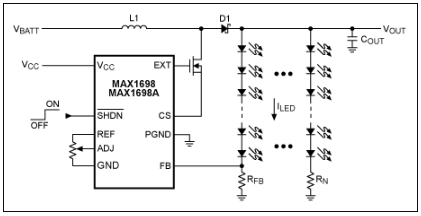
MAX6970為8端口�、36V恒流LED驅(qū)動器�����,采用4線串口�����。利用本應(yīng)用筆記提供的信息�,MAX6970配合MAXQ2000 16位RISC微控制器使用���,可以在選擇不同按鍵時得到各種簡單的LED排序。
2023-06-12 16:10:39 293
293 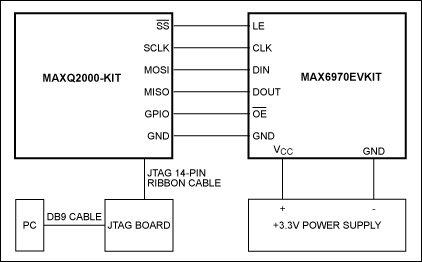
MAX6951/MAX6950 SPI LED驅(qū)動器簡單易用的共陰極顯示器驅(qū)動器���,通過SPI串行接口連接微控制器。MAXQ系列微控制器集成了SPI模塊,可通過SPI接口與LED驅(qū)動器通信�����。這里介紹的例程有助于用戶理解MAX6951的LED驅(qū)動功能。也可將該例程應(yīng)用到類似的MAXQ2000系統(tǒng)開發(fā)中�����。
2023-06-16 15:34:12 533
533 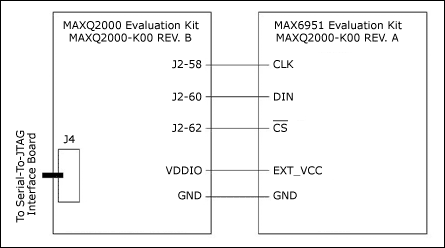
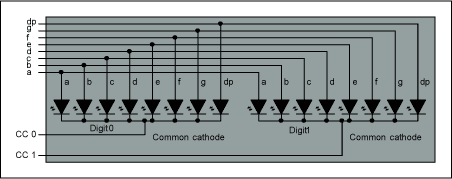
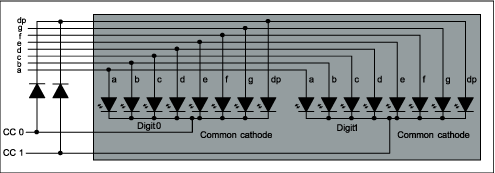
 電子發(fā)燒友App
電子發(fā)燒友App




































































評論